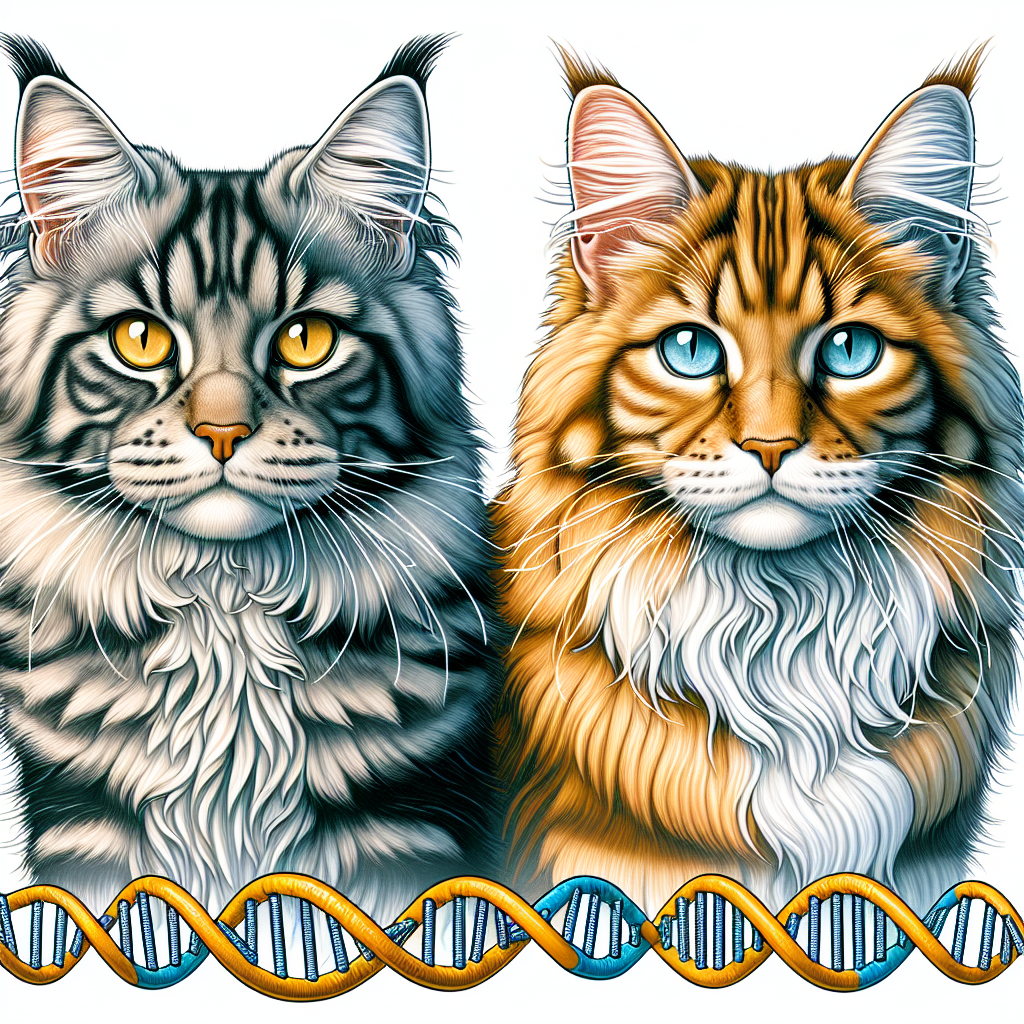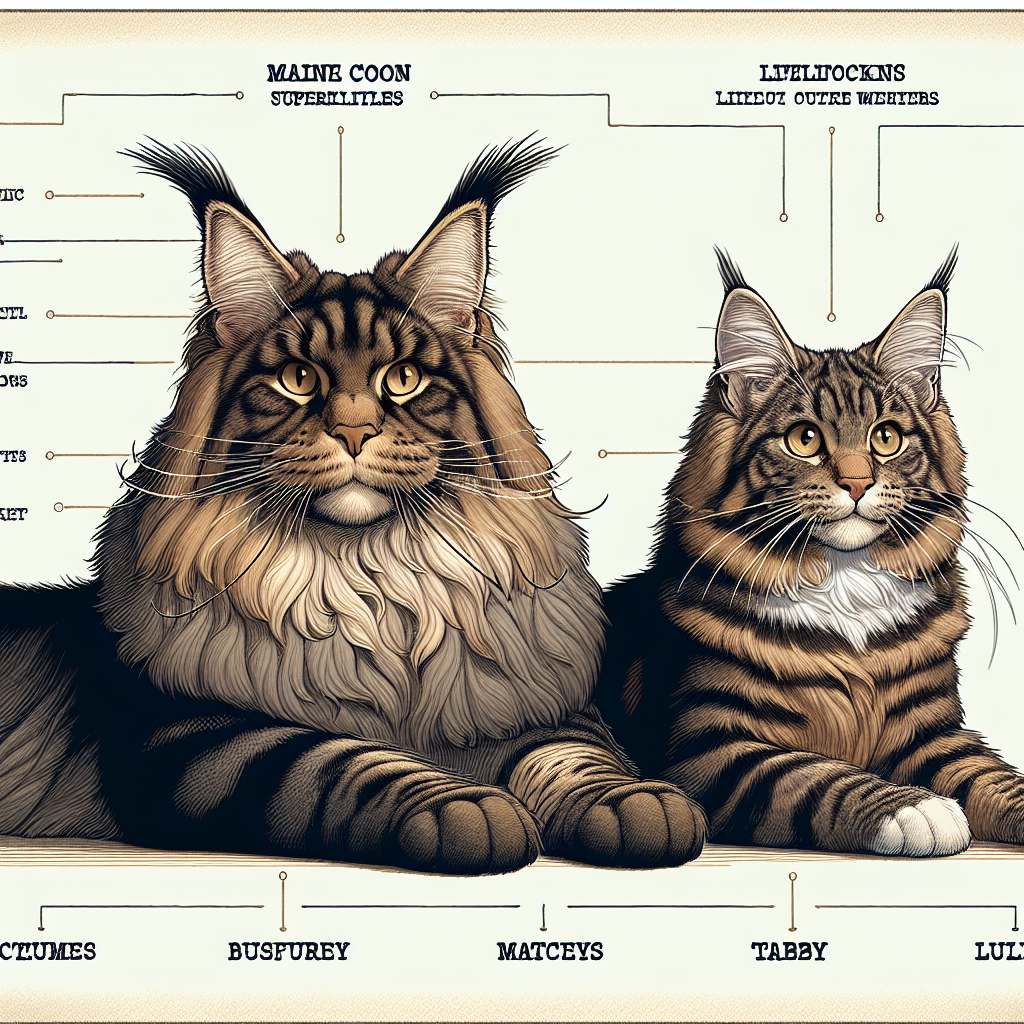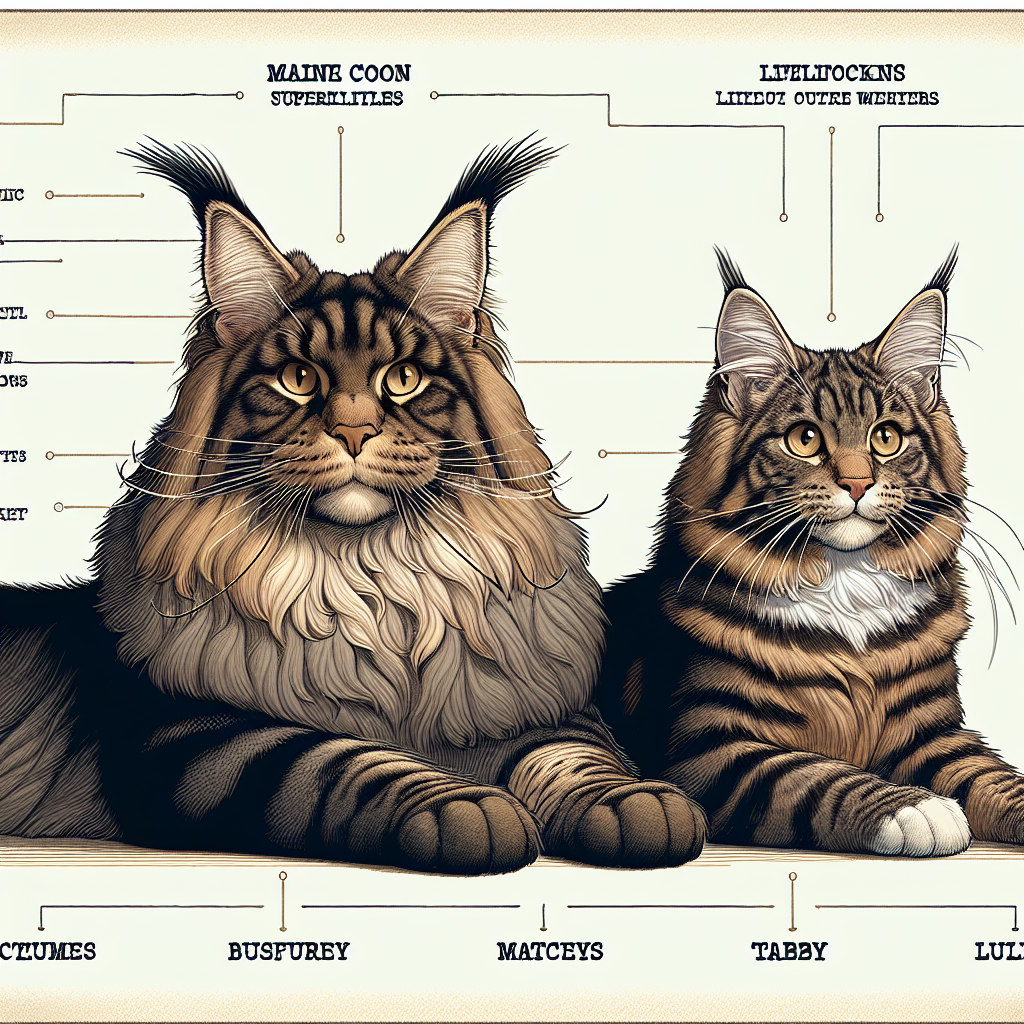Have you ever wondered if Maine Coons are considered tabby cats? Maine Coons, known for their large size and friendly personalities, are indeed often classified as tabbies. However, their classification goes beyond a simple label. With their distinct markings, Maine Coons showcase a wide range of tabby patterns that make them unique and highly sought after among cat enthusiasts. Let’s explore the fascinating world of Maine Coons and delve into what it means for them to be tabby cats.
The Maine Coon Breed
The Maine Coon cat is a fascinating breed known for its unique and distinctive features. Originating in the state of Maine, in the northeastern United States, the Maine Coon has a rich history and has become one of the most beloved cat breeds worldwide. With their impressive size, charming personalities, and stunning tabby coat patterns, Maine Coons captivate the hearts of cat lovers everywhere.
Origins and History
The exact origins of the Maine Coon breed remain somewhat of a mystery. There are numerous theories surrounding their ancestry, with some suggesting they are descendants of longhaired cats brought over by Viking explorers and others speculating that they are the result of natural crossbreeding between domestic cats and raccoons. While the latter theory is purely a myth, it speaks to the Maine Coon’s distinctive raccoon-like tail and tufted ears.
Maine Coons were first recognized as a breed in the late 19th century and were exhibited at cat shows in the United States. They quickly gained popularity, particularly in the New England region, due to their resilience, adaptability, and friendly nature. Despite facing challenges during the rise of other cat breeds, the Maine Coon has endured and is now one of the most sought-after and beloved breeds globally.
Physical Characteristics
Maine Coons are known for their impressive size and sturdy build. They are considered one of the largest domestic cat breeds, with males weighing between 13 to 18 pounds and females ranging from 8 to 12 pounds. Their bodies are muscular and well-proportioned, giving them a regal and elegant appearance.
One of the most distinctive physical features of the Maine Coon is their large, expressive eyes. These cats have beautiful almond-shaped eyes that come in various shades, from green and gold to copper and even blue. Their faces are broad with high cheekbones, giving them a friendly and approachable expression.
The Maine Coon’s coat is another standout feature. It is long, thick, and weather-resistant, evolved to withstand the harsh New England winters. Their coat comes in various colors and patterns, but the most common and well-known is the tabby pattern, which will be further explored in the following sections.
Personality and Temperament
Maine Coons are renowned for their friendly and sociable nature. They are known as “gentle giants” due to their friendly and affectionate personalities. Maine Coons are highly adaptable cats that get along well with children, other pets, and even strangers. They are often described as dog-like in their loyalty and their tendency to follow their owners around the house.
These cats are intelligent and playful, often retaining their kitten-like energy well into adulthood. They enjoy interactive toys and games, and many even learn to fetch. Despite their large size, Maine Coons are gentle and patient, making them ideal companions for families and individuals alike.

Tabby Cats
Tabby cats, on the other hand, refer to a coat pattern rather than a specific breed. Tabby is not a breed but a pattern that can be found in various cat breeds, including the Maine Coon. Tabby cats are known for their distinctive striped, spotted, or marbled coat patterns, and they are one of the most common coat patterns in domestic cats worldwide.
Description
Tabby cats can come in various colors and patterns, making each individual unique. They can range from orange tabbies with brown stripes to gray tabbies with silver markings, and every combination in between. The tabby pattern is usually characterized by agouti hairs, which have different bands of color along each hair shaft.
Tabby Coat Patterns
There are several recognized tabby coat patterns, each with its own unique characteristics.
-
Classic Tabby: This pattern features broad, swirling stripes on the cat’s body, often resembling the letter “M” on the forehead. The body has multiple rings or bands around the tail and legs.
-
Mackerel Tabby: This pattern showcases narrow, straight stripes that run vertically along the cat’s body, resembling fishbones. The tail may have ringed or unbroken stripes.
-
Spotted Tabby: As the name suggests, this pattern features spots or rosettes instead of stripes. The spots can vary in size, shape, and distribution, creating a striking and eye-catching appearance.
-
Ticked Tabby: This pattern is characterized by agouti hairs with different shades, which give the coat a finely speckled or “salt and pepper” appearance. The tabby markings may be subtle, especially on the body, but may be more pronounced on the face and legs.
-
Other Tabby Variations: Tabby patterns can also come in various combinations and variations, including patched tabbies, torbie (a mix of tabby and tortoiseshell), and silver tabbies (with a silver-gray base color).
Genetics of Tabby Cats
The tabby coat pattern is determined by specific genes, and its inheritance can be quite complex. Tabby patterns are usually governed by polygenes, which are multiple genes working together to produce the desired coat pattern. The exact combination of these genes determines whether a cat will have a classic, mackerel, spotted, or other tabby pattern.
Tabby patterns can also be influenced by variations and mutations in these genes, leading to a wide range of appearances within the tabby coat pattern. Selective breeding has played a role in maintaining and enhancing specific tabby coat patterns in certain breeds, including the Maine Coon.

The Connection Between Maine Coons and Tabby Cats
Maine Coons and tabby cats are intricately connected through the presence of tabby coat patterns in the Maine Coon breed. While not all Maine Coons are tabby, the majority do exhibit tabby coat patterns in various forms. This connection is partly due to the prevalence of tabby patterns in domestic cats overall, as well as the historical presence of tabby cats in Maine.
Tabby Coats in Maine Coons
Tabby coats are frequently seen in Maine Coons, and they add to the breed’s unique charm. Whether it’s the classic tabby with its swirls and “M” marking on the forehead, or the mackerel tabby with its fishbone-like stripes, these patterns enhance the beauty and individuality of each Maine Coon.
Variations in Tabby Patterns
Within the Maine Coon breed, there is significant variation in the tabby patterns exhibited by individual cats. Some Maine Coons may have bold and prominent tabby markings, while others may possess more subtle or diluted tabby patterns. Factors such as the specific combination of genes, selective breeding, and individual variations contribute to these differences in tabby coat patterns.
Distinctive Features of Maine Coons
Aside from their tabby coats, Maine Coons have several distinctive features that set them apart from other breeds.
Size and Structure
One of the defining characteristics of Maine Coons is their exceptional size. They are considered one of the largest domestic cat breeds, with a long and muscular body. Their sturdy structure and substantial weight give them an imposing presence that demands attention and admiration.
Facial Features
Maine Coons have captivating facial features that contribute to their charm. Their faces are broad with high cheekbones, giving them a sweet and friendly expression. Their large, expressive eyes are another standout feature, radiating intelligence and affection.
Ear Tufts and Lynx Tips
A unique feature that distinguishes Maine Coons is the presence of ear tufts and lynx tips. These cat-specific traits give them a wild and exotic appearance, further emphasizing their connection to their rumored raccoon ancestry.
Feathered Tails
Maine Coons have long, luxurious tails that are often compared to a plume or feather duster. These tails are thick and bushy, adding to the overall elegance and regality of the breed. Their tails also serve a practical purpose, providing balance and stability when navigating different terrains.
Mature Coat Development
Maine Coon kittens may not fully develop their characteristic coats until they reach their adult stage. The maturation process involves shedding their kitten fur and growing in a more substantial and luscious adult coat. This development can take several months or even years, contributing to their unique and awe-inspiring appearance.
Tabby Coat Patterns in Maine Coons
As previously mentioned, tabby coat patterns are commonly found in Maine Coons. Let’s explore the different tabby patterns that can be observed in this breed:
Classic Tabby
The classic tabby pattern on a Maine Coon features distinctive bold swirls on the sides of the body, often forming a “bull’s eye” type pattern on the flank. The tail and legs display prominent rings, and the face showcases the notable “M” marking on the forehead. This pattern exudes elegance and sophistication.
Mackerel Tabby
Maine Coons with mackerel tabby patterns have narrow, straight stripes running vertically along their bodies, resembling fishbones. Their tails may display unbroken or ringed stripes, enhancing their striking appearance. Mackerel tabbies possess a playful and energetic aura.
Spotted Tabby
This tabby pattern showcases striking spots or rosettes on the cat’s coat. Spotted tabby Maine Coons have spots of varying sizes and shapes, creating a visually captivating effect. These cats have a captivating and adventurous spirit.
Ticked Tabby
Ticked tabby Maine Coons possess a coat with delicate, subtle patterns reminiscent of salt and pepper. Their tabby markings are less pronounced on their bodies but may be more noticeable on their face and legs. Ticked tabbies exude an air of grace and subtlety.
Other Tabby Variations
Maine Coons can exhibit variations and combinations of tabby patterns, including patched tabbies, torbie (a blend of tortoiseshell and tabby), and silver tabbies (with a silver-gray base color). These unique variations add to the diversity and beauty of the Maine Coon breed.
Inheritance of Tabby Coats
The inheritance of tabby coats involves complex genetic mechanisms that influence the specific patterns and variations observed in Maine Coons and other cat breeds.
Genetic Basis
The tabby coat pattern is influenced by multiple genes working together, commonly referred to as polygenes. These polygenes determine whether a cat will exhibit a classic, mackerel, spotted, ticked, or other tabby pattern. The specific combination and interaction of these genes result in the desired coat pattern.
Polygenes
Polygenes contribute to the variation and complexity observed in tabby patterns. They allow for the expression of different intensities of striping, spotting, or ticking, ultimately leading to the wide range of tabby coat patterns seen in Maine Coons and other breeds.
Variations and Mutations
Mutations in the genes responsible for tabby coat patterns can lead to variations within the tabby pattern itself. These variations may result in different intensities of striping, variations in the shapes and sizes of spots or rosettes, or unique combinations of tabby patterns.
Selective Breeding
Selective breeding plays a crucial role in maintaining and enhancing specific tabby coat patterns in Maine Coons. Breeders selectively choose cats with desirable tabby patterns and mate them to produce offspring with the desired coat characteristics. This process allows for the preservation and improvement of distinctive tabby patterns within the breed.
The Tabby Coat: More Than Meets the Eye
Tabby coats are not only visually striking but also offer a wealth of variety when it comes to colors and markings.
Tabby Fur Colors
Tabby coats can come in various colors, ranging from warm hues such as red, orange, and brown to cooler shades like silver and gray. These colors can mix and blend, creating unique combinations that make each tabby cat truly one of a kind.
Tabby Markings
In addition to the pattern itself, tabby coats can exhibit various markings within the pattern. These markings can include bold lines or spots, delicate flecks, or even marbled patches. These distinctive markings contribute to the individuality and beauty of each tabby cat.
Tabby with White
Some tabby cats also have white patches on their coat, creating a striking contrast between the tabby pattern and the white areas. This combination can result in vibrant and eye-catching cats that are sure to turn heads.
Tabby and Other Coat Patterns
It’s important to note that tabby patterns can also appear alongside other coat patterns in cats. It is not uncommon to find Maine Coons or tabby cats with tabby patterns on specific parts of their bodies, such as their faces or tails, while displaying a solid or patched pattern on the rest of their coat. These combinations enhance the overall beauty and uniqueness of these felines.
Popular Misconceptions
There are a couple of misconceptions that often arise when discussing Maine Coons and tabby cats.
All Maine Coons are Tabby
While tabby patterns are quite common in Maine Coons, not all Maine Coons are tabby. Maine Coons can also come in solid colors, such as black, white, cream, or gray, and other patterns like tortoiseshell, calico, and bicolor. Tabby Maine Coons, however, do have a significant presence within the breed.
Not All Tabby Cats are Maine Coons
The presence of tabby patterns is not exclusive to Maine Coon cats. Tabby patterns can be found in various domestic cat breeds, ranging from domestic shorthairs to Bengals and Scottish Folds. Tabby cats can have backgrounds spanning different breeds, making the tabby coat pattern a widespread and popular choice among cat lovers.
Choosing a Maine Coon or Tabby Cat
When it comes to choosing between a Maine Coon and a tabby cat, there are several factors to consider.
Preferences in Coat Patterns
If you have a specific preference for tabby coat patterns and admire their distinct beauty, a Maine Coon with tabby markings might be the perfect choice for you. However, if you appreciate the variety and versatility of coat patterns found in tabby cats from various breeds, you may opt for a tabby cat with a different lineage.
Personality Considerations
While both Maine Coons and tabby cats can have friendly and sociable personalities, it’s essential to consider the individual cat’s temperament and needs. Maine Coons are known for their sociability and adaptability, making them great companions for families and individuals seeking an affectionate and playful cat. Tabby cats, on the other hand, can exhibit a wide range of personalities depending on their specific breed and individual characteristics.
Health and Care
When deciding between a Maine Coon and a tabby cat, it’s important to consider their specific health and care requirements. Maine Coons, due to their large size, might be more prone to certain health issues such as hip dysplasia and heart disease. Regular grooming is also necessary to maintain their luxurious coat. Tabby cats, regardless of breed, may have unique health considerations, so it’s crucial to research the specific breed traits and potential health concerns that come with a tabby cat.
Conclusion
Maine Coons and tabby cats have captivated the hearts of cat lovers across the globe. The Maine Coon breed, with its remarkable size, distinctive features, and tabby coat patterns, continues to be a favorite among cat enthusiasts. Whether you’re drawn to the bold and elegant classic tabby or the enchanting spotted tabby pattern, the beauty of tabby cats and the Maine Coon breed is undeniable. Before choosing your feline companion, carefully consider your preferences, lifestyle, and commitment to providing love, care, and attention to ensure a happy and fulfilling life for your new furry friend.

